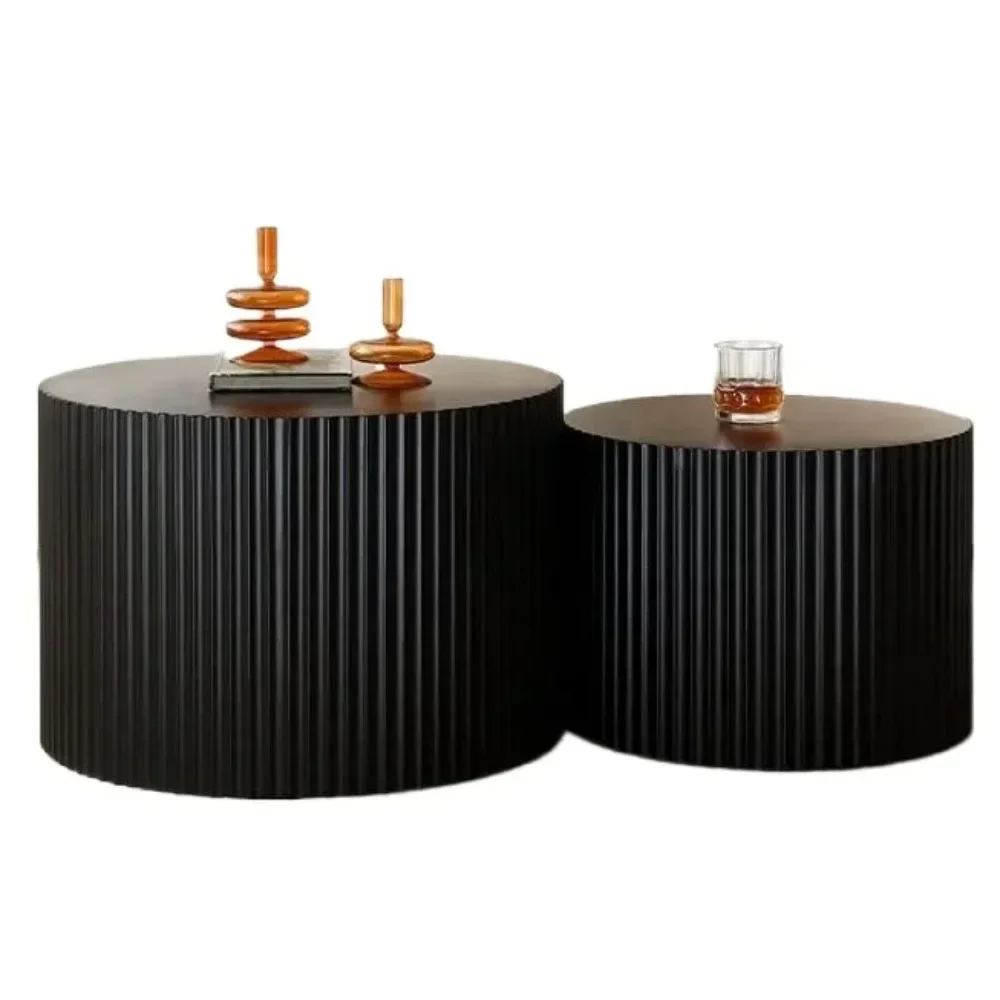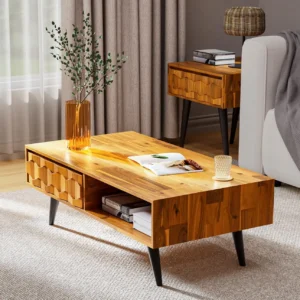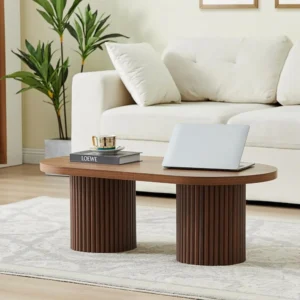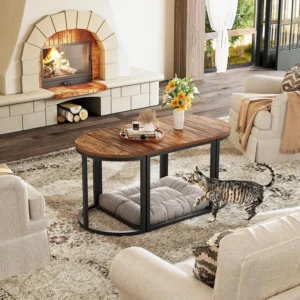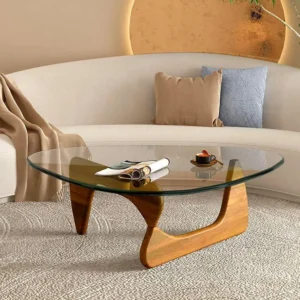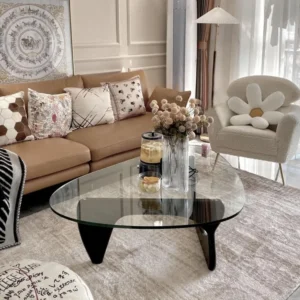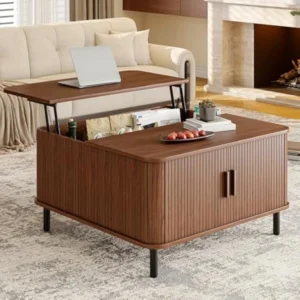Understanding the Enduring Appeal of Mid-Century Modern Coffee Tables
Mid-Century Modern design represents an influential era spanning roughly from the 1930s to the mid-1960s that continues to captivate homeowners today. This design movement has maintained its popularity for good reason – its clean lines, organic forms, and functional beauty speak to our desire for both style and practicality in home furnishings.
What makes mid-century coffee tables particularly timeless is their perfect balance of form and function. These pieces feature:
- Clean, uncluttered lines that feel fresh in any decade
- A mix of organic and geometric shapes that add visual interest
- Honest use of natural materials like walnut, teak, and oak
- Functional designs that prioritize usability alongside aesthetics
These coffee tables serve as more than just practical surfaces – they function as artistic statements that anchor living spaces. Many intelligent black mid-century coffee tables showcase this dual purpose perfectly, combining striking design with everyday functionality.
The mid-century design philosophy embraced the idea that good design should be accessible to everyone, not just the wealthy. This democratic approach used new manufacturing techniques and materials to create beautiful, durable pieces for the average home.
Today’s renewed interest in these vintage-inspired designs stems from their remarkable versatility. Mid-century coffee tables complement everything from minimalist apartments to eclectic family homes, making them a natural fit for black mid-century coffee table design concepts in almost any interior style.
Round vs. Oval: A Comprehensive Comparison for Your Space
When selecting a mid-century coffee table, shape is one of the most consequential decisions you’ll make. The choice between round and oval affects not just aesthetics, but also functionality, traffic flow, and how people interact in your space.
Let’s compare these two classic shapes across several important factors:
| Feature | Round Tables | Oval Tables |
|---|---|---|
| Visual Impact | Creates focal point, softer feel | Directional, elegant elongation |
| Space Efficiency | Works in square rooms, smaller footprint | Fits rectangular rooms better, more surface area |
| Traffic Flow | Easy to navigate around from all sides | Directs movement along its length |
| Safety | No sharp corners, ideal for families | Smoother edges than rectangular tables |
| Room Compatibility | Perfect for square rooms, conversation areas | Complements rectangular spaces, longer sofas |
| Surface Utilization | Central access from all sides | More usable surface area |
| Common Materials | Walnut, teak, glass, marble | Similar materials, often with more elaborate bases |
| Typical Leg Style | Pedestal, tripod, splayed legs | Four legs, hairpin style, sled bases |
Understanding these differences helps you determine which shape might better suit your specific needs. Many homeowners are drawn to the design benefits of round mid-century tables for their ability to create natural gathering spots and visual harmony.
The right choice ultimately depends on your room dimensions, existing furniture, and how you plan to use the table in daily life. Let’s explore each option in greater detail.
The Distinctive Charm of Round Mid-Century Coffee Tables
Round mid-century coffee tables possess a unique ability to foster connection and create visual harmony in living spaces. Their circular shape naturally encourages face-to-face interaction, making them ideal centerpieces for conversation areas.
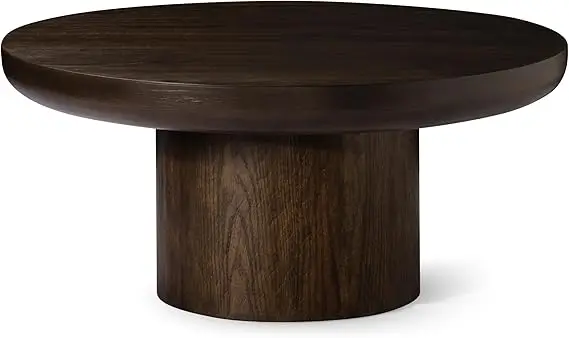
Advantages of Round Tables:
- Create a sense of unity and flow in the room
- Eliminate sharp corners – safer for homes with children
- Complement sectional sofas beautifully by softening their angular lines
- Work exceptionally well in smaller spaces
- Facilitate equal access from all seating positions
- Balance rooms with too many straight lines and rectangular shapes
Limitations to Consider:
- Provide less surface area than similarly-sized oval tables
- May feel undersized when paired with very long sofas
- Can appear unbalanced in highly rectangular rooms
- Limit the number of people who can comfortably use the table simultaneously
Round mid-century tables often feature distinctive design elements like subtly lipped edges that prevent items from falling off, minimalist tops that showcase the beauty of natural wood grain, and sculptural bases that create visual interest from every angle.
When selecting a round table, size matters significantly. For intimate settings or smaller rooms, tables between 30-36 inches in diameter work well. Larger living rooms can accommodate tables of 40+ inches in diameter without overwhelming the space.
Our collection of mid-century modern round coffee tables offers various diameters and heights to match your specific space requirements and design preferences.
The Elegant Versatility of Oval Mid-Century Coffee Tables
Oval mid-century coffee tables offer a sophisticated compromise between round and rectangular shapes. They combine the gentle, flowing lines of circular tables with the practical advantages of linear organization – creating pieces that feel both graceful and functional.
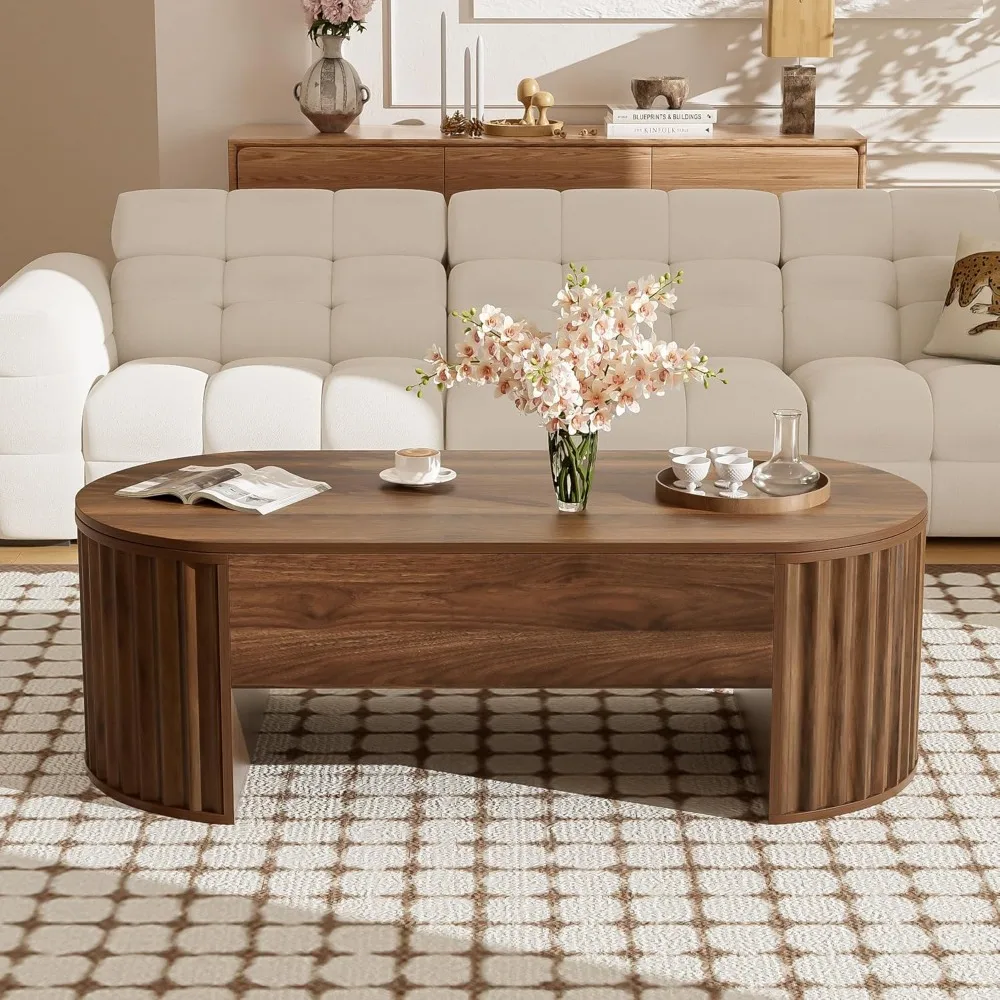
Advantages of Oval Tables:
- Provide more surface area than round tables of similar width
- Create natural directional flow in rectangular rooms
- Pair exceptionally well with longer sofas and seating arrangements
- Maintain the safety benefits of curved edges with no sharp corners
- Allow more people to access the table simultaneously
- Add sophisticated curves to rooms with predominantly straight lines
Limitations to Consider:
- Can feel awkward in perfectly square rooms
- May compete visually with very round furniture pieces
- Often require more space than round tables
- Can dictate a more formal furniture arrangement
Oval mid-century tables frequently showcase distinctive design features like sculpted edges that emphasize their flowing shape, inlays of contrasting materials that follow their curves, and uniquely positioned legs that provide both stability and visual interest.
When selecting an oval coffee table, proportion is key. These tables typically work best when they’re about 1/2 to 2/3 the length of the sofa they accompany. This balance ensures the table feels proportional to your seating arrangement.
Browse our selection of mid-century modern oval coffee tables to find options that will complement your existing furniture while adding a touch of mid-century elegance.
Iconic Mid-Century Coffee Table Designs That Defined an Era
The mid-century period produced some of the most recognizable and influential coffee table designs in furniture history. These groundbreaking pieces challenged conventional notions of what furniture could look like and how it could be manufactured.
Several designs from this era became so iconic that they continue to influence furniture design today:
- The Noguchi Table (1947) – a sculptural piece featuring a freeform glass top balanced on two identical wooden pieces
- The Eames Elliptical Table – an elongated oval surface with thin wire legs, emphasizing negative space
- The Nelson Platform Bench – which doubled as both seating and table surface
- The Pearsall Boomerang Table – featuring asymmetrical, organic shapes
- The Danish Modern teak tables – showcasing the beauty of natural wood and fine craftsmanship
These revolutionary designs introduced several innovations:
- The use of new manufacturing techniques allowing for curved plywood
- Exploration of biomorphic forms inspired by nature
- Introduction of mass-production methods for designer furniture
- Mixing materials in unexpected ways (glass, wood, metal, laminate)
- Creating furniture that appeared to “float” with visually light bases
What makes these designs truly timeless is their perfect balance of artistry and function. They reject unnecessary ornamentation in favor of honest expression of materials and purpose – principles that align perfectly with many styles that go well with mid-century modern aesthetics.
Understanding these iconic pieces helps develop an eye for quality and authenticity when selecting your own mid-century coffee table.
Finding Your Perfect Fit: Room Size and Layout Considerations
Selecting the right coffee table shape requires careful assessment of your living space dimensions and layout. Taking time to measure and plan will ensure your table enhances both the function and flow of your room.
Space Assessment Guidelines:
- Allow 12-18 inches of clearance between the coffee table edge and seating
- Ensure pathways around the table are at least 30 inches wide for comfortable movement
- Consider the table’s height – it should be level with or 1-2 inches lower than your seating
- For proper proportion, aim for a coffee table that’s about two-thirds the length of your main sofa
Round tables work particularly well in:
* Square or compact rooms where space is limited
* Areas with multiple entry points requiring flexible pathways
* Rooms where furniture is arranged in a circle for conversation
* Spaces with too many straight lines that need softening
Oval tables shine in:
* Rectangular rooms that echo their elongated shape
* Spaces with longer sofas that need proportional tables
* Narrow rooms where traffic flow needs to be directed
* Family rooms where more surface area is beneficial
The functional uses of round mid-century tables extend beyond aesthetics – they can actually make smaller spaces feel more open by eliminating sharp corners that visually “cut” into the room.
For unusual room configurations, consider how people move through the space. A round table allows multidirectional traffic flow, while an oval table tends to create pathways along its sides.
Matching Your Coffee Table to Your Seating Arrangement
Your seating configuration plays a crucial role in determining whether a round or oval coffee table will work best in your space. The right pairing creates visual harmony and ensures comfortable access for everyone seated.
For L-shaped sectionals: Round coffee tables often work best, as they soften the angular nature of the sectional while providing equal access from both sides of the “L.” The circular shape creates a natural focal point that unifies the seating arrangement.
For straight, long sofas: Oval coffee tables typically complement this arrangement better, as they mirror the elongated shape of the sofa. This pairing feels proportional and balanced, with the table providing accessible surface area along the entire sofa length.
For floating furniture arrangements: Round tables excel when seating is positioned away from walls, creating a self-contained conversation area. The symmetrical nature of a round table makes it accessible from all sides.
For mixed seating with chairs and sofas: Consider which shape better balances the visual weight of your arrangement. Often, round tables help anchor asymmetrical seating groups by providing a central focus point.
For complex living areas, mid-century modern coffee table sets offer coordinated solutions that can address multiple seating zones while maintaining design cohesiveness.
Remember that the coffee table should serve everyone seated comfortably – nobody should need to stretch or stand to reach it, regardless of which shape you choose.
Material Matters: Authentic Mid-Century Elements and Finishes
The materials used in mid-century coffee tables are as important as their shapes in creating authentic period appeal. These carefully selected materials were chosen not just for their beauty, but also for their ability to express the design principles of the era.
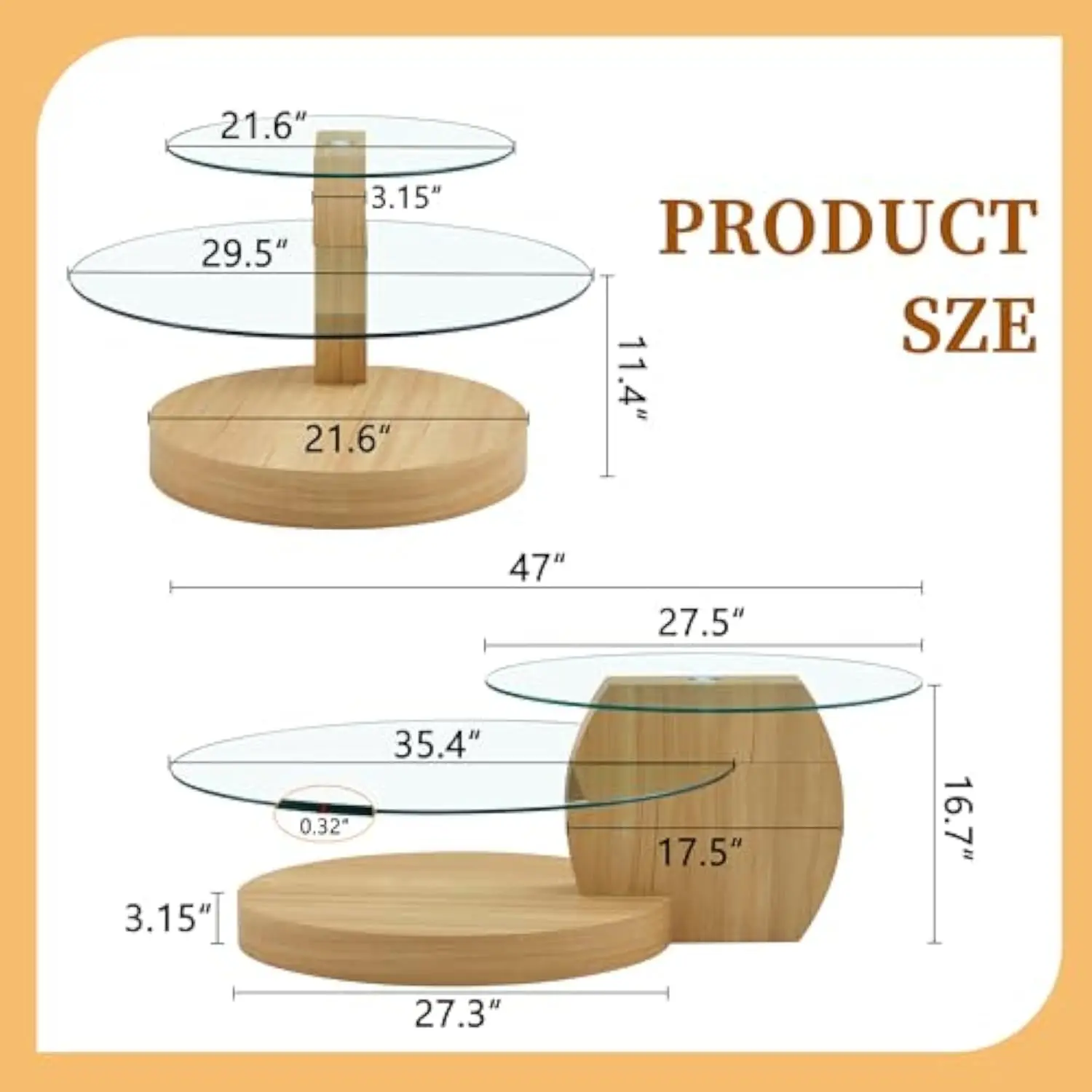
Signature Wood Types:
* Walnut – prized for its rich, dark tones and beautiful grain patterns
* Teak – valued for its durability and warm golden-brown coloration
* Oak – appreciated for its strength and distinctive grain texture
* Rosewood – used in premium designs for its exotic, deep coloration
Glass Applications:
* Clear glass – creating visual lightness and revealing architectural bases
* Smoked glass – adding sophistication and depth
* Textured glass – providing visual interest while obscuring what’s below
Stone Elements:
* Marble – offering luxurious, cool surfaces with unique veining
* Travertine – providing natural texture and earthy tones
* Terrazzo – incorporating colorful chips in a polished cement matrix
Metal Components:
* Brass – adding warm metallic accents that patina beautifully
* Chrome – creating reflective, sleek details that feel modern
* Powder-coated steel – offering durable, colorful structural elements
The mid-century era also embraced innovative materials that were new at the time, including fiberglass, molded plywood, and various plastic laminates. These materials allowed designers to explore organic shapes that weren’t possible with traditional manufacturing techniques.
Our mid-century modern glass top coffee tables showcase how transparent surfaces can highlight the architectural beauty of table bases while creating a sense of openness in your space.
When selecting a mid-century coffee table, consider how these materials will age and patina over time – many develop richer character with use, which is part of their enduring appeal.
Styling Your Mid-Century Coffee Table with Purpose
Styling a mid-century coffee table requires thoughtful curation that respects the table’s design while enhancing its functionality. The goal is to create an arrangement that feels intentional without overwhelming the table’s inherent beauty.
For Round Tables:
1. Work with the circular shape by arranging items in groupings rather than rows
2. Create layers with varying heights, but keep objects low enough for cross-table conversation
3. Consider the view from all angles since people will approach the table from different directions
4. Use a circular tray to corral smaller items while echoing the table’s shape
For Oval Tables:
1. Follow the directional flow of the oval with your arrangement
2. Create a central focal point with smaller groupings at either end
3. Use the elongated shape to establish zones for different purposes (drinks, books, decorative objects)
4. Consider a linear tray that complements the table’s shape
General Styling Principles:
* Follow the “rule of three” by grouping objects in odd numbers
* Include items with varying heights, textures, and materials
* Allow negative space to showcase the table’s design
* Balance decorative objects with functional items
Coffee table books about architecture, design, or art make ideal styling elements that honor the mid-century appreciation for knowledge and culture. Small sculptural objects, ceramic vessels, and natural elements also complement the era’s aesthetic sensibilities.
For more specific inspiration, our guide on styling black mid-century coffee tables offers ideas that can be adapted to tables of any finish or material.
Authentic Vintage vs. Contemporary Reproductions: Making Your Choice
When shopping for a mid-century coffee table, you’ll face the choice between authentic vintage pieces and contemporary reproductions. Both options have distinct advantages worth considering.
Authentic Vintage Pieces:
Pros:
* Genuine historical connection and craftsmanship
* Unique character and patina developed over decades
* Often made with old-growth woods no longer available
* Potential investment value that may appreciate over time
* Sustainability benefits of reusing existing furniture
Considerations:
* May require restoration or have existing damage
* Potentially higher price points for designer pieces
* Limited availability of specific designs
* Possible structural weaknesses from age
* No standardized dimensions or warranties
Contemporary Reproductions:
Pros:
* Consistent quality and pristine condition
* Modern manufacturing improvements for durability
* Wide availability and variety of options
* Often more affordable than authentic designer pieces
* Standardized dimensions that work with modern rooms
Considerations:
* Lack of historical authenticity
* Variable quality depending on manufacturer
* May use different materials than originals
* Less unique character and story
When evaluating vintage pieces, look for quality markers like dovetail joints, solid wood construction, and maker’s marks. For reproductions, examine the craftsmanship carefully, focusing on material quality, finish consistency, and structural integrity.
Our mid-century modern vintage coffee tables collection offers pieces that capture the authentic spirit of mid-century design while meeting contemporary quality standards.
Where to Find Your Perfect Mid-Century Coffee Table
Finding the ideal mid-century coffee table requires knowing where to look and what questions to ask during your search.
Sources for Vintage Mid-Century Tables:
* Specialty mid-century dealers and showrooms
* Estate sales and auctions
* Online marketplaces specializing in vintage furniture
* Antique malls with mid-century sections
* Thrift stores and flea markets (requiring a keen eye)
Sources for Quality Reproductions:
* Design-focused furniture retailers
* Specialty manufacturers dedicated to mid-century style
* Online retailers with strong customer reviews
* Showrooms that allow you to examine pieces in person
Questions to Ask Before Purchasing:
* What materials are used in construction?
* How is the piece assembled and finished?
* For vintage: Has it been restored or refinished?
* What are the exact dimensions?
* What is the weight capacity?
* How is the table packaged and delivered?
Mid-Century Modern Solid Wood Coffee Tables, Mid-Century Modern Teak Coffee Tables
$879.95 Select options This product has multiple variants. The options may be chosen on the product pageMid-Century Modern Danish Coffee Tables, Mid-Century Modern Oval Coffee Tables, Mid-Century Modern Solid Wood Coffee Tables
$390.05 Select options This product has multiple variants. The options may be chosen on the product pageMid-Century Modern Coffee & End Table Sets, Mid-Century Modern Coffee Table Sets, Mid-Century Modern Oval Coffee Tables
Price range: $257.48 through $331.04 Select options This product has multiple variants. The options may be chosen on the product pageMid-Century Modern Glass Top Coffee Tables, Mid-Century Modern Glass Top Side & End Tables
$460.58 Select options This product has multiple variants. The options may be chosen on the product pageMid-Century Modern Glass Top Coffee Tables, Mid-Century Modern Vintage Coffee Tables, Mid-Century Modern Vintage Side & End Tables
$725.36 Select options This product has multiple variants. The options may be chosen on the product pageMid-Century Modern Lift Top Coffee Tables, Mid-Century Modern Square Coffee Tables
$454.73 Select options This product has multiple variants. The options may be chosen on the product page
At Hearth Forms, our mid-century modern coffee tables collection has been carefully curated to include both round and oval options that meet exacting quality standards while honoring authentic design principles.
When making your final selection, consider not just the immediate appeal of the piece, but how it will serve your needs and enhance your space for years to come.
Beyond the Table: Creating a Cohesive Mid-Century Living Space
Your coffee table serves as an anchor for your living space, but achieving a harmonious mid-century look involves considering how it relates to other elements in the room.
Complementary Furniture Pieces:
* Side tables that echo your coffee table’s materials or design language
* Lighting with similar lines – consider arc floor lamps or sputnik chandeliers
* Seating with complementary wood tones and clean lines
* Storage pieces that share design DNA with your coffee table
The mid-century philosophy embraced the idea of “total design” – creating spaces where all elements work together cohesively. This doesn’t mean matching everything perfectly; rather, it means establishing visual connections through materials, colors, or design principles.
For smaller spaces or flexible arrangements, mid-century modern nesting coffee tables offer versatility while maintaining design integrity. These adaptable pieces can expand when needed or tuck away to create more floor space.
Creating Balance:
* Mix warm wood tones with cooler materials like glass or metal
* Incorporate organic shapes to soften geometric furniture
* Add textiles with period-appropriate patterns to complement wood furniture
* Include plants to enhance the mid-century connection to nature
Remember that even the most authentic mid-century spaces today incorporate contemporary elements. The goal is to create a living environment that honors mid-century principles without feeling like a museum.
Maintenance Tips for Long-Lasting Mid-Century Coffee Table Beauty
Proper care ensures your mid-century coffee table remains beautiful for generations to come. Different materials require specific maintenance approaches to preserve their integrity and appearance.
Wood Care:
* Dust regularly with a soft, dry cloth
* Clean with a slightly damp cloth and mild soap when needed
* Apply appropriate wood conditioners or oils periodically
* Use coasters to prevent water rings and heat damage
* Keep out of direct sunlight to prevent fading and wood movement
Glass Surface Care:
* Clean with appropriate glass cleaner and lint-free cloths
* Avoid abrasive cleaners that might scratch the surface
* Clean spills immediately to prevent damage to the frame
* Use felt pads under objects to prevent scratches
Metal Component Care:
* Wipe clean with a soft cloth
* Use appropriate metal polishes for brass or chrome elements
* Address any oxidation promptly to prevent spreading
* Apply protective waxes to uncoated metals if recommended
General Protection:
* Use felt pads on the bottom of the table legs to protect your floors
* Lift rather than drag the table when moving it
* Address any loose joints or hardware promptly
* Consider using tablecloths or placemats when the table is used for dining
With proper care, your mid-century coffee table – whether round or oval – will continue to be both a functional centerpiece and a design statement in your home for many years to come.

